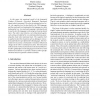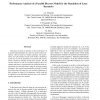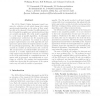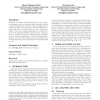367 search results - page 67 / 74 » Amalgamation of cellular automata |
SASO
2008
IEEE
14 years 1 months ago
2008
IEEE
Abstract— On the one hand, natural phenomena of spontaneous pattern formation are generally random and repetitive, whereas, on the other hand, complicated heterogeneous architect...
ISMVL
2007
IEEE
14 years 1 months ago
2007
IEEE
In this paper the emotional model of the humanoid Cynthea (Cybernetic Networked Humanoid Emotional Agent) robot is presented. The robot is explained at two levels: the cognitive l...
ICPPW
2006
IEEE
14 years 1 months ago
2006
IEEE
This paper presents an analysis on the performance of a parallel implementation of a discrete model of laser dynamics, which is based on cellular automata. The performance of a 2D...
IPPS
2006
IEEE
14 years 1 months ago
2006
IEEE
The GCA (Global Cellular Automata) model consists of a collection of cells which change their states synchronously depending on the states of their neighbors like in the classical...
GLVLSI
2005
IEEE
14 years 1 months ago
2005
IEEE
Quantum-dot Cellular Automata (QCA) is a novel computing mechanism that can represent binary information based on spatial distribution of electron charge configuration in chemica...




